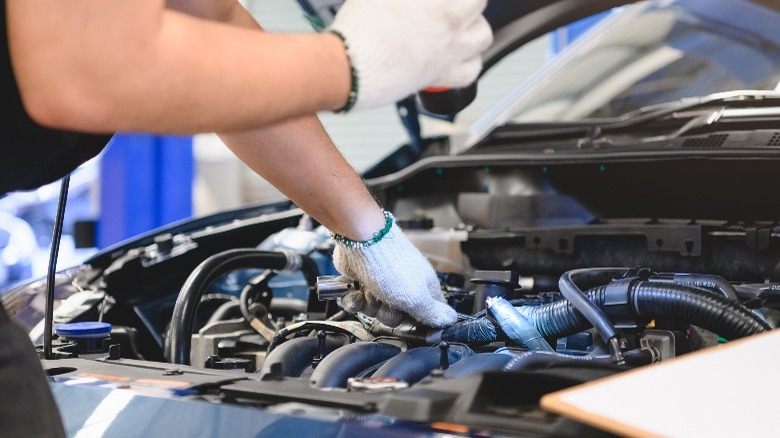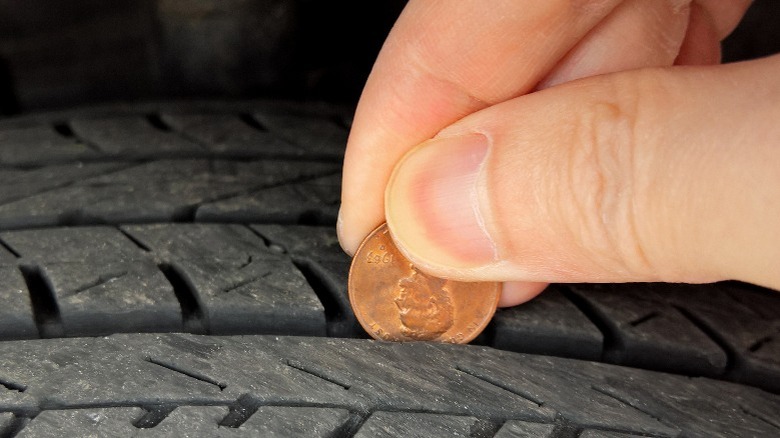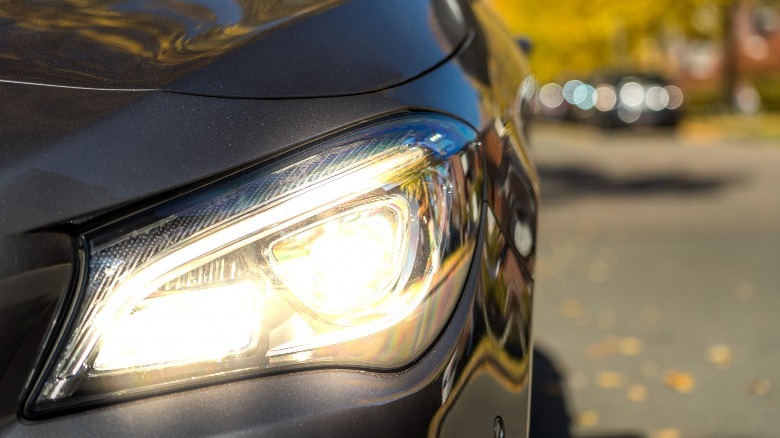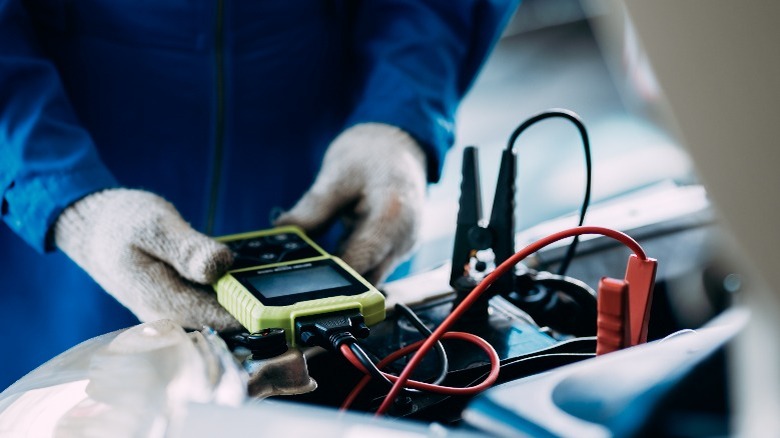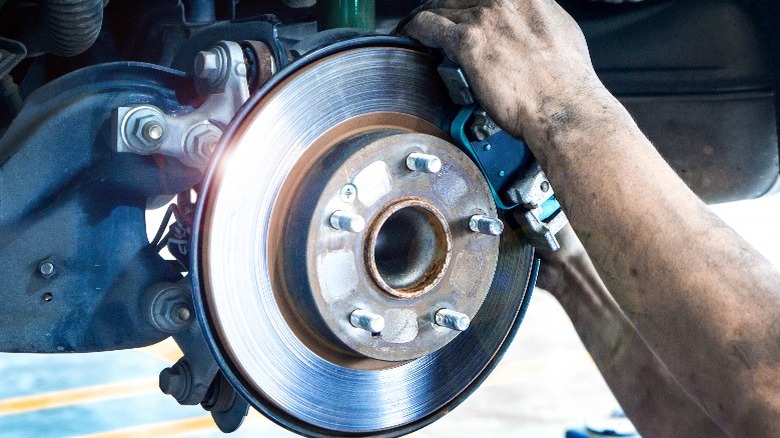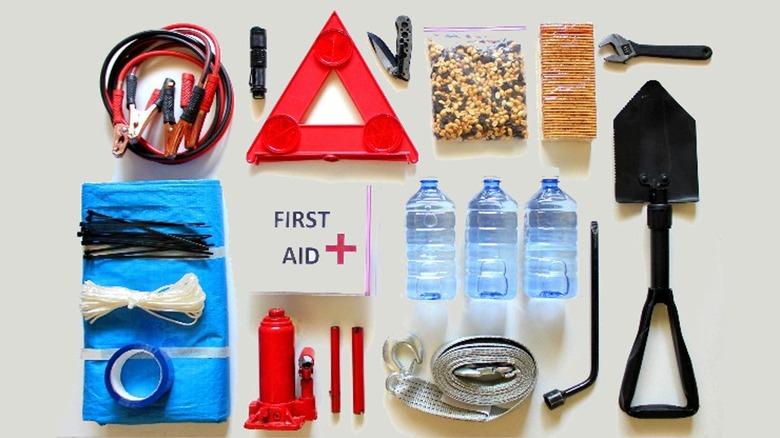Road Trip Checklist: How To Prepare Your Car For Adventure
Summer is quickly approaching, and with it comes the season of exploration and adventure. For many, that means hitting the roads in search of new sights and experiences. If you're planning to set out on an adventure this summer — or during any other time of the year, for that matter — your first priorities are probably picking your destination and planning your itinerary. While those tasks are some of the most enjoyable parts of preparing for a vacation, they aren't the only things you need to do. If you're going to drive your car for an extended period on the interstate, you need to ensure that it's capable of handling the rigors of highway driving.
Don't worry. Preparing your car for a road trip isn't as hard as it sounds, and you should be able to accomplish every task on this list in one afternoon. That said, pre-road trip inspections are critical for ensuring your safety and the safety of your passengers on the interstate. The fact that it's a simple process should only increase your motivation to complete it. So, from checking under the hood to inspecting your tire tread and brakes, here's how to prepare your car for a road trip adventure.
Check your belts, hoses, and fluid levels
Your car's engine bay contains more than just the motor. It's home to innumerable other components that play vital roles in helping the engine run and keeping your wheels moving. Many of those parts get their power from a serpentine or drive belt. If the belt has damage, like fraying or large cracks, or if it's too loose or too tight, it could break or malfunction, causing you to lose several accessories, like AC and power steering. Other components and systems rely on hoses to carry fluid between various parts — for example, your vehicle's radiator hoses are responsible for transporting coolant between the engine and radiator.
All of these parts are critical for your engine to function smoothly and correctly. Before you set out on a road trip, it's essential that you inspect these components to confirm that they're in good condition. You should check all fluid levels — including coolant, engine oil, brake fluid, power steering fluid, and transmission fluid, if applicable — before you hit the road. Confirm that each level is within the appropriate range by checking your owner's manual or reading the marks on the fluid reservoirs or dipsticks. Additionally, you need to inspect your belts and hoses.
Visually inspect your belts for cracks and fraying. To test the belt's tension, turn it sideways. You should be able to turn the belt about 90 degrees — any more or less, and the belt may be too tight or loose. Finally, check your fluid hoses, especially the radiator hoses. Look for any cracks or bulges. Squeeze the hoses in your fingertips, and if they feel overly spongy or soft, you should consider replacing them before you hit the highway.
Inspect your tire pressure and condition
Without quality tires, your car won't make it very far. A flat tire can quickly ruin a vacation and leave you stranded for hours, especially if you don't have a quality spare or your tire blows in a remote area. It's impossible to avoid flat tires entirely — even if you have brand-new, high-quality rubber, you could drive over a nail or other hazard. That said, taking the proper precautions can help you prevent tire damage and vacation-ruining blowouts.
Before you hit the road, take a few minutes to inspect your tires' condition and air pressure levels. You'll need to check the tread depth to ensure your tires have adequate grip on the road in various weather conditions. The easiest way to check tread depth is to purchase a cheap tread depth gauge from your local auto parts store. Alternatively, you can use what's referred to as the penny method. Grab a standard U.S. penny, and place it upside down in your tire's tread. If all of Lincoln's head is visible, you need new tires.
Finally, you also need to check your tire pressure. As a general rule of thumb, most tires should have around 35 psi. If your vehicle has extremely large tires, they may require more air pressure. That said, one of the best ways to confirm your tires' ideal pressure is to check the placard in your driver's door jam. Remember, however, that if you've installed aftermarket tires, the correct psi level may be different. In that case, check your tires' sidewall to discover the proper pressure rating.
Confirm that key accessories function
Some of your car's accessories are powered by a serpentine or drive belt, like the air conditioning, and we've already covered how to inspect the belts. However, other accessories are electric and get their power from your vehicle's electrical system. Ultimately, many of these accessories can trace their power to the serpentine belt, thanks to the alternator. But there are a lot of other components in between that can fail and cause things like power windows, the radio, and headlights to stop working. It's vital that you check all of these accessories before leaving on your trip to ensure that your drive is safe and comfortable.
Start by confirming that key interior accessories work. Check your power windows, windshield wipers, radio, seatbelts, and dashboard lights and gauges. You'll also need to confirm that your exterior accessories function. Get a friend to help you check your car's lights by standing outside as you turn on the turn signals, brake lights, reverse lights, hazard lights, low beams, and high beams.
Finally, check to make sure your vehicle's horn works and verify that all of your mirrors are properly adjusted and unobstructed. If any accessory doesn't work, the first thing you should do is check your fuses. If your fuses are in good condition and a light doesn't work, you may have a blown bulb. If you've checked all of these things and an accessory still doesn't function, you should visit a professional mechanic to repair the problem before hitting the road.
Check your battery
Your car's battery is a critical component that allows you to start the vehicle with a turn of the key or a press of the start button. It also allows you to use accessories, like the radio and AC, without starting the engine. The 12-volt batteries that modern cars use typically need to be replaced every three to five years. They're able to last so long thanks to the alternator, which charges the battery as you drive. However, alternator problems or power drains can cause your battery to fail prematurely. It's a wise idea to check your battery before you set out on a road trip.
One of the best and easiest ways to inspect your car's battery is to visit a local auto parts store. There, the employees will most likely test your vehicle's battery and alternator for free. If your battery is weak or there's an issue with the alternator, the test will pick it up and let you know, allowing you to buy a new battery or fix the alternator before you break down on the highway. Alternatively, you can visit a mechanic for this service, but you should expect to pay a fee. The upside to visiting a mechanic over an auto parts store is that, even though you'll likely have to pay, the technician can inspect your entire vehicle, including all of the other components covered here, and tell you whether your car is highway safe.
Inspect the brakes
It's no secret that brakes are one of the most vital safety features of a car. They enable you to slow down and stop your vehicle and keep it stationary until you're ready to move again. However, brakes aren't magical components that stop your car on their own — at least not for most vehicles. Brakes require both driver input and maintenance to function properly. Most vehicles need brake pad replacements every 25,000 to 65,000 miles. But in between replacements, and especially before a big road trip, you need to check your brake system for damage and wear.
Before hitting the highway, take a few minutes to inspect your brake system. We already touched on the brake fluid above, but that's not the only part of the system you need to check. You'll also need to visually inspect the brake pads for wear. On most vehicles, you can do this by peering through your wheel's spokes with a flashlight. New brake pads provide about 10 to 12 millimeters of friction material. If your brake pads are less than 3 millimeters thick (roughly the size of one U.S. penny stacked on top of a U.S. nickel), they need to be replaced. If you can't see your brakes without removing the wheels, you still need to inspect them, but you'll have to pull the wheels off yourself or visit a professional mechanic for an inspection service.
Update your emergency kit or build one
So far, we've covered parts of your car that you need to inspect before heading out on a road trip. Make no mistake — performing a pre-trip inspection is essential for ensuring your safety on the highway, but it can't provide you with 100% protection. Accidents happen, and sometimes, things are simply out of our control, no matter how well we prepare. To help maximize your safety and plan for every possible scenario, it's worth putting together an emergency kit to keep in your car. That way, if the worst happens and you become stranded or face an unforeseen problem with your vehicle, you can stay safe and comfortable until help arrives.
Some of the things you should have in your emergency kit include jumper cables, hazard lights or emergency markers, first-aid supplies, extra water, some blankets, basic tools, food that won't quickly expire, like granola bars or canned goods, a power bank to charge your devices, and some way to signal for help, like a flare gun or ham radio. Most of those items aren't too pricey, and you can find many of them at local auto parts stores or even places like Walmart and Amazon. Even if you never need your emergency kit, it's better to have it and not need it than to find yourself stranded in the middle of nowhere with no cell service or way home.

